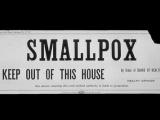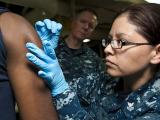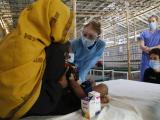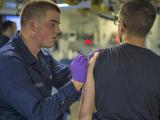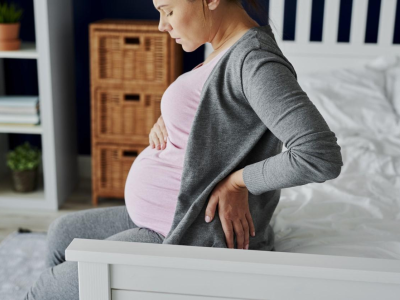Dec 19, 2002 (CIDRAP News) VaxGen Inc., a California biotechnology company, announced plans this week to seek US licensing for an attenuated smallpox vaccine that is considered safer than existing vaccines but was developed too recently to be proved effective against the disease.
The Brisbane, Calif., company said the vaccine, called LC16 Kaketsuken, was developed in Japan and licensed there in 1980, after smallpox was eradicated. VaxGen has agreed with the vaccine's Japanese manufacturer, the Chemo-Sero-Therapeutic Research Institute, or Kaketsuken, to pursue regulatory approval of the vaccine in the United States. The company wants to start clinical trials early in 2004, in the hope of obtaining a US license by the end of the year, Chief Executive Lance K. Gordon, PhD, said at a Dec 17 news conference.
The vaccine was tested in 50,000 Japanese schoolchildren and caused no serious side effects, VaxGen officials said. The vaccine induces a pockevidence of an immune responsein more than 95% of recipients, officials said at the news conference, a recording of which was made available by the company.
"We believe LC16 is a better match for the risk profile during a period of time when any adverse effects associated with [smallpox] vaccine will be quite evident, but the advantages of protection against the disease are theoretical," Gordon said.
Currently licensed smallpox vaccines such as Dryvax, the foundation of the US smallpox vaccine stockpile, are considered the most dangerous vaccines in use. Experts say they could cause about 15 life-threatening reactions and one or two deaths per million people vaccinated. In a program that President Bush announced last week, Dryvax is being used to immunize some military personnel and will soon be administered to healthcare workers volunteering for it.
Dryvax and similar vaccines were grown on the skin of calves, whereas LC16 is produced in laboratory cell culture. The US government is buying millions of doses of another smallpox vaccine produced in cell culture, made by Acambis and Baxter, but it is not expected to be licensed until 2004.
Gordon said LC16 was derived from the Lister strain of vaccinia virus. In a standard textbook, Vaccines (edited by Plotkin and Orenstein and published by W.B. Saunders, 1999), smallpox expert D.A. Henderson commented favorably on the vaccine. "This strain produced a satisfactory immune response in humans (HI [hemagglutination inhibition] and neutralizing antibodies), and in a field trial of 50,000 persons, it was found to produce a markedly lower frequency of reactions than that noted for other strains," he wrote. He also called LC16 "more satisfactory" than another attenuated vaccine, the modified vaccinia Ankara (MVA).
However, Henderson also noted that LC16 was developed too late to have a track record against the actual disease. "The achievement of smallpox eradication precluded use of this [LC16] vaccine under circumstances of natural challenge," he wrote. Smallpox was declared eradicated in 1980.
Describing LC16, Gordon said, "It is able to propagate on the surface of the skin but was specifically designed to not have a significant potential to cause systemic or life-threatening events. It does meet World Health Organization requirements; it does induce a 'take,' or pock, which for 200 years has been the accepted evidence of smallpox immunization."
In a clinical trial, LC16 was compared with the Lister strain and another strain of vaccinia, Gordon said. It induced a take in more than 95% of recipients, not significantly different from the other vaccines, and also induced high levels of neutralizing antibodies, he said. Further, side effects, including fever, redness, and pustule size, were significantly reduced in the LC16 recipients.
But in response to questions, Gordon said the vaccine probably would not be recommended for people with risk factors for serious vaccinia complications, such as weakened immunity, eczema, or pregnancy. "It is still a live virus, and therefore would likely be contraindicated until such time as very carefully controlled studies could be done to evaluate safety," he said.
Gordon said VaxGen will soon have informal discussions with the Food and Drug Administration about the licensing process. "We anticipate starting clinical trials very early in the year," he said. Because the vaccine has already been extensively tested and licensed in another industrialized country, he said he was hoping for a fast track: "My hope is that we will have the vaccine qualified in the US in 2004."
In a Dec 18 New York Times report, Dr. Phillip Russell, an adviser on bioterrorism vaccines to the US Department of Health and Human Services, said the attenuated vaccine was made in an unusual type of cell culture, which could be an obstacle to licensing. However, he said the government was pleased that VaxGen is seeking licensing because the vaccine might provide an option for the future.
VaxGen officials said their joints plans with Kaketsuken call for the Japanese company to manufacture the vaccine and export it to the United States. But VaxGen could make the vaccine if US demand exceeded Kaketsuken's capacity, officials said.
